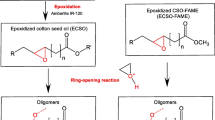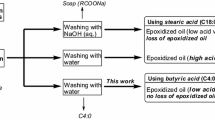Abstract
Epoxidized vegetable oils are desirable chemicals due to their eco-friendly characteristics and their being a major source of many green products. Ring opening is one of the ways to convert these epoxidized oils to some new intermediates. The use of mono-functional amines, alcohols, acid anhydrides and thioethers for epoxy ring opening has been reported in the literature. In this study, thioglycolic acid (TGA) bearing thiol and carboxylic acid as two different functional groups and methyl ester of thioglycolic acid (TGAME) were used. Currently, there is no reported literature describing epoxy ring opening using chemicals
bearing two different functional groups simultaneously. In this way, two new polyols were synthesized, one with TGA (polyol 1) and one with TGAME (polyol 2). FTIR and 1H- and 13C-NMR spectroscopy confirmed that the ring was opened by the carboxylic acid group of TGA, and the thiol group was not involved in the ring opening whereas the ring was opened by the thiol group in the case of TGAME.







Similar content being viewed by others
References
Rhee I (1996) Evolution of environmentally acceptable hydraulic fluids. NLGI Spokesman 60:28–35
Thames SF, Blanton MD, Mendon S, Subramanian R, Yu H (1998) Surfactants and fatty acids: plant oils. In: Kaplan DL (ed) Biopolymers from renewable resources. Springer, Berlin, pp 267–271
Williams GI, Wool RP (2000) Composites from natural fibers and soy oil resins. Appl Compos Mater 7:421–432
Liu ZS, Erhan SZ, Calvert PD (2007) Solid free form fabrication of epoxidized soybean oil/epoxy composite with bis or polyalkyleneamine curing agents. Compos Appl Sci Manuf 38:87–93
Lu Y, Larock RC (2006) Novel biobased nanocomposites from soybean oil and functionalized organoclay. Biomacromolecules 7:2692–2700
Campanella A, Rustoy E, Baldessari A, Baltanas MA (2010) Lubricants from chemically modified vegetable oils. Bioresour Technol 101:245–254
Fogassy G, Ke P, Figueras F, Cassagnau P, Rouzeau S, Courault V (2011) Catalyzed ring opening of epoxides: application to bioplasticizers synthesis. Appl Catal General 393:1–8
Scala L, Wool RP (2002) Effect of FA Composition on epoxidation kinetics of TAG. J Am Oil Chem Soc 79:373–378
Lin Yang B, Yang L, Dai H, Yi A (2008) Kinetic Studies on oxirane ring cleavage of epoxidized soybean oil by methanol and characterization of polyols. J Am Oil Chem Soc 85:113–117
Narine SS, Kong X, Bouzidi L, Sporns P (2007) Physical properties of polyurethanes produced from polyols from seed oils: elastomers. J Am Oil Chem Soc 84:55–63
Biswas A, Adhvaryu A, Gordon SH, Erhan SZ, Willet JL (2005) Synthesis of diethylamine functionalized soybean oil. J Agric Food Chem 53:9485–9490
Lee KW, Hailan C, Yinhua J, Kim YW, Chung KW (2008) Modification of soybean oil for intermediates by epoxidation, alcoholysis and amidation. Korean J Chem Eng 25:474–482
Park SJ, Jin FL, Lee JR (2004) Synthesis and thermal properties of epoxidized vegetable oil. Macromol Rapid Commun 25:724–727
Sharma BK, Advaryu A, Liu Z, Erhan SZ (2006) Chemical modification of vegetable oils for lubricant applications. J Am Oil Chem Soc 83:129–136
Sharma BK, Advaryu A, Liu Z, Erhan SZ (2006) Synthesis of hydroxy thio-ether derivatives of vegetable oil. J Agric Food Chem 54:9866–9872
Sharma BK, Liu Z, Adhvaryu A, Erhan SZ (2008) One-pot synthesis of chemically modified vegetable oils. J Agric Food Chem 56:3049–3056
Desroches M, Caillol S, Auvergne R, Boutevin B, David G (2012) Biobased cross-linked polyurethanes obtained from ester/amide pseudo-diols of fatty acid derivatives synthesized by thiol-ene coupling. Polym Chem 3:450–457
Dai H, Yang L, Lin B, Wang C, Shi G (2009) Synthesis and characterization of the different soy-based polyols by ring opening of epoxidized soybean oil with methanol, 1,2-ethanediol and 1,2-propanediol. J Am Oil Chem Soc 86:261–267
Acknowledgments
The authors acknowledge the financial support of The Research Fund of Sakarya University (BAP) (Project no: 2013-02-04-054).
Author information
Authors and Affiliations
Corresponding author
About this article
Cite this article
Karadeniz, K., Akı, H., Sen, M.Y. et al. Ring Opening of Epoxidized Soybean Oil with Compounds Containing Two Different Functional Groups. J Am Oil Chem Soc 92, 725–731 (2015). https://doi.org/10.1007/s11746-015-2638-z
Received:
Revised:
Accepted:
Published:
Issue Date:
DOI: https://doi.org/10.1007/s11746-015-2638-z




